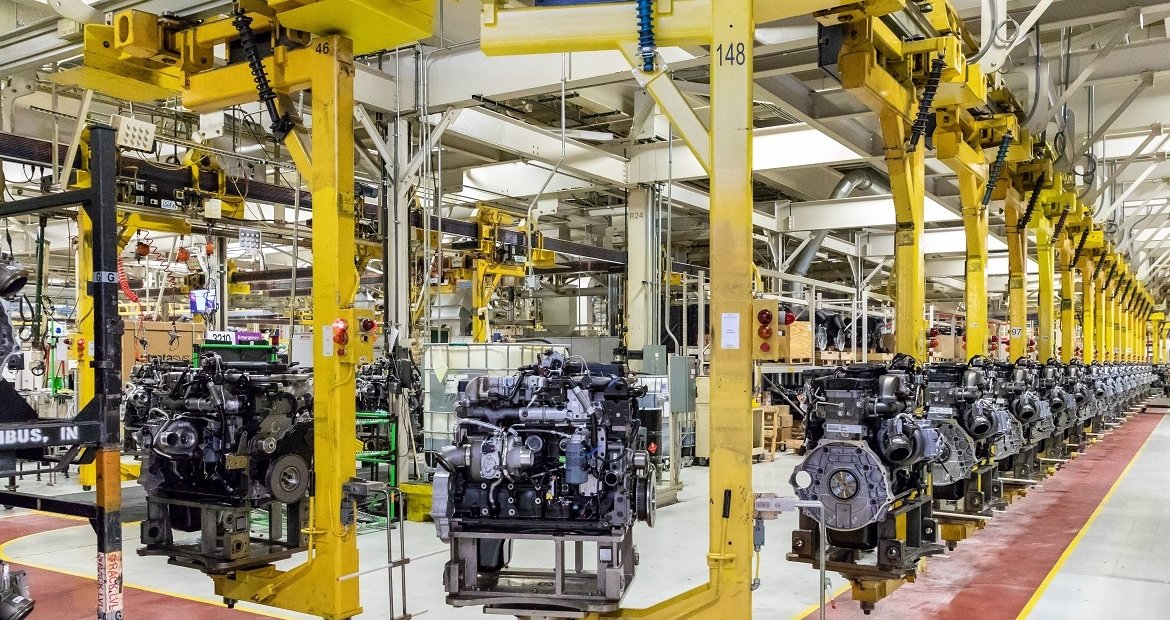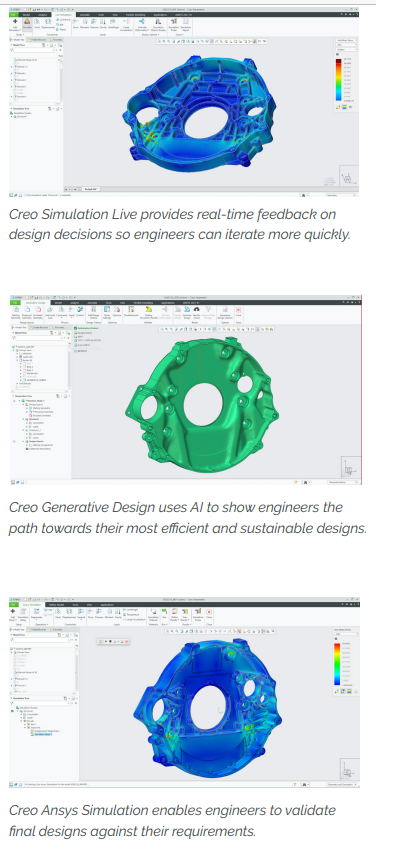Global Power Leader Cummins Optimizes New Product Designs to Prioritize Sustainability
With Creo, Cummins is Reducing Material Waste, Saving Time, and Making Engineers More Productive
Cummins is always innovating
A multi-billion-dollar company, Cummins is the world’s largest independent diesel and gas engine designer and manufacturer and a leading supplier of electrification systems, including fuel cells and battery systems. Widely admired, Cummins ranks in the top 6% on Newsweek’s list of America’s Most Responsible Companies and has spent 14 consecutive years on Ethisphere World’s Most Ethical Companies list. As an energy-producing business, Cummins has long made it a company goal to reduce their environmental impact.
Tackling a global climate challenge requires doing more with less
As a global leader in social and environmental responsibility, Cummins is committed to doing their part to create a more sustainable, prosperous world. That’s why Cummins launched PLANET 2050, a novel environmental sustainability strategy that sets goals for the entire company for 2030, along with longer-term aspirations dating out to 2050. By 2030, Cummins aims to achieve several milestones. For example, they plan to reduce absolute greenhouse gas emissions from facilities and operations by 50%; create a Circular Lifecycle Plan for Every Part to use less, use better, and use again; and generate 25% less waste in facilities and operations as percent of revenue.
The sustainability goals Cummins have set are ambitious, especially given that Cummins produces more than 1 million engine products per year. Such a large production output requires a significant number of material and natural resources as well as adherence to ever more rigorous environmental regulations. With sustainability in mind, Cummins set out to rethink their design process. About 70% of an item’s lifecycle CO2 footprint is set during its design, meaning that if Cummins wants to minimize a product’s environmental impact, it needs to be done during the design phase. Given that Cummins is centered on optimization on all fronts as part of PLANET 2050, focusing on the design phase can yield rewards ranging from lowering costs to environmental benefit.
The right design tools cannot guarantee innovation, but they can help create circumstances where it is more likely to occur. That’s why Cummins is using Creo, a leading 3D computer-aided design (CAD) tool trusted by designers and engineers around the globe.

Cummins applies simulation-driven design to optimize resources with Creo’s generative capabilities
Cummins knows that in the world of power solutions, getting to market faster while optimizing for environmental sustainability across operations, manufacturing, and service often traces back to sound design practices. After design engineers describe the engineering and operations requirements for the task, Creo offers up a suite of design and simulation tools to aid the development of the design concept. This process enables their design engineers to develop and iterate on design concepts more efficiently, avoiding the typical back and forth work that occurs between the designer and analyst and allowing for a much more effective use of these critical resources. Furthermore, this allows them to explore possibilities they previously would have never been able to explore because of time restraints.
Leveraging Creo Generative Topology Optimization, Creo Simulate, and Creo Simulation Live (CSL), Cummins is designing and testing digital prototypes to understand how they will perform in a real-world engine system. Creo Simulation Live provides real-time feedback on design decisions so designers can iterate more quickly and generate more options, which saves designers an incredible amount of time. Each time a change is made, it’s analyzed in seconds as part of the typical workflow—all without leaving the CAD environment for greater efficiency.
For Cummins, there are several benefits to this approach. Leveraging generative design and CSL, they can get design functionally right the first time without having to go back and forth with the analyst to ensure the component meets its required design limits. Moving simulation upfront in their design process helps them cut costs, create better products, and get to market faster. Doing this ensures any tooling required to manufacture the part is designed right the first time by testing basic scenarios, rapidly iterating, and advancing models to the point where analysts can spend more time on issues that merit their expertise.
As such, the process only requires analysts to validate the results, ultimately allowing them to focus on more complex analysis tasks. “Having a lot of back-and-forth interactions between designers and analysts is really a pretty poor use of resources,” says David Genter, Director of Design Engineering at Cummins. “It takes away a lot of time from the analysts to do the more complex analyses that they’re uniquely trained to do. The more we rely on the analysts to do the routine work that could be done in the design engineering realm, the more we’re pulling the analyst away from the work that can only be done by them.”
With a complete suite of analysis tools embedded within Creo, the designer can do much of the initial analysis that’s needed, especially on the iterative side, without much training since the tools are much more intuitive to use than many of the pure analysis tools.
Cummins is also investing in additive manufacturing to reduce part count and designing features that are not manufacturable through traditional means. Given that 3D-printed metal parts are generally more costly than those made by traditional manufacturing methods, Cummins is placing their initial focus on the use of special CO2 intensive materials such as stainless steel and Inconel. With the use of these materials, the natural next step is investing in additive manufacturing, given that the combined efficiencies could tip the scales toward better performance and even more savings.
As a plus, with additive manufacturing, they don’t have to worry as much about draft angles, machine set-ups, and other traditional manufacturing constraints. Therefore, they can leverage generative design and CSL to freely explore shapes that are more organic as well as alternative materials that might not be associated with traditional manufacturing. “With additive manufacturing, your design freedom becomes a lot greater, enabling many of the more organic designs stemming from Creo Generative Topology Optimization to become manufacturable with less functional compromise,” says Genter.
PTC’s LEARN to offer Creo certification to Cummins designers
LEARN Online is a subscription-based online, instructor-led training program from PTC University that provides users with a prolific catalog of courses on how to become power users of PTC technology. It offers certification programs that cover both fundamental and more advanced professional knowledge and skills for various products, enabling Creo-users to become more proficient modelers and expand their use of Creo-based simulation modules like Creo Generative Topology Optimization. Through LEARN Online, PTC offers an objective means for assessing proficiency on modeling and other functionalities in Creo. As part of its companywide goals to invest in employee learning, use tools and resources more efficiently, and exceed increasingly strong environmental standards, Cummins is encouraging its designers to explore the deeper functions of Creo through its LEARN Online licenses.
Cummins is using LEARN Online to not only improve skills of individual designers, but also to spread awareness of Creo’s vast capabilities among its more than 4,000 users within the company. “One of the big things we’re doing is making people aware that these capabilities are embedded within Creo. Most of these capabilities have always been there, but before, people didn’t necessarily have incentive to investigate them. But now that we’re exposing them to these different Creo modules through LEARN Online, users are finding that it’s a great way to use more of their design engineering capabilities while showcasing and being recognized for developing their skill set,” says Genter.
“With additive manufacturing, your design freedom becomes a lot greater, enabling many of the more organic designs stemming from Creo Generative to become manufacturable with less functional compromise.”David Genter,
Director of Design Engineering at Cummins
Cummins is currently working with PTC to implement the industry’s first Designer Simulation Certification program. This program has been successfully piloted in 2021 through the Professional Certification program and has been refined to offer a specific program centered around simulation modules such as Creo Simulation Live, Creo Simulate, Generative Design, and Creo Flow Analysis. With this program, Cummins will be able to objectively tie a level of modeling and simulation proficiency expectation to a certain point in a design engineer’s career.

An added benefit to the Designer Simulation Certification initiative is that generative design will guide engineers through good design practice, showing where structure and contour should be placed to best accommodate load and flow paths respectively—a process that takes time for design engineers to develop over their career. With generative design, this process is more intuitive and expedited—especially for new engineers—and allows engineers to better develop their design concepts right the first time. This, along with avoiding the back-and-forth with the analyst, will shorten the overall design process while producing material-optimized products.
Just by using the tool, they grow their intuition and come up to speed in developing viable concepts much more quickly, making them more valuable designers. Ultimately, LEARN Online has provided Cummins Design Engineers with a tangible means for improving and assessing their modeling and analysis capabilities.
“What I tell people now is that nobody will ever tell you that you’re too good of a modeler,” says Genter. “You will never regret becoming an expert modeler because it allows you to do your work faster, improve the maturity of your design concepts, and continue to exercise more of your engineering capabilities. We know that once people become better modelers, they will be more apt to stray into other modules within Creo. LEARN Online gives them the confidence to do that.”
Creo helps Cummins solidify their role as stewards of the planet
With sustainable products and practices among the highest business priorities, Creo is providing significant gains within Cummins’ design program. Cummins has realized that applying generative design to any conventionally designed part typically reduces the material used by 10 to 15 percent. This approach reduces the environmental footprint and the cost and weight for any given component.
Cummins is taking a critical step toward achieving their sustainability goals by implementing a Circular Lifecycle Plan for Every Part they design. Optimizing a component to minimize material-use is now a basic expectation for the part they design, and formally woven into their Corporate Design Review standards to support meeting PLANET 2050 goals.
As part of the Circular Lifecyle Plan for Every Part, Cummins provides written documentation that they’ve chosen the best material specification and process; that they applied material optimization techniques, such as generative design; and that they devised a recycling, remanufacturing, and reuse plan for every newly designed component.
This approach underscores their commitment to sustainability. “We’re taking very seriously the amount of material that we put into our new designs and the amount of water that is required to manufacture them. Given that most of the CO2 footprint is determined within an item’s design phase, if you don’t utilize generative, or if you choose a suboptimal material that can’t be recycled, reused, or remanufactured, that ship sails very early in the whole design and development process,” says Genter.
“As employees of Cummins, we’re expected to act as stewards of the planet, and what that means is we’re taking very seriously the amount of material that we put into our new designs and the amount of water that is required to manufacture them.”David Genter,
Director of Design Engineering at Cummins








